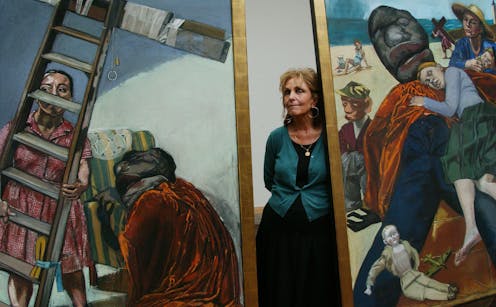
The great feminist artist Paula Rego has died at the age of 87 after a short illness. An image-maker of enormous talent, her work has been variously described as disturbing, visceral, mysterious and surreal.
Paula Rego was born in Lisbon in 1935, in the years following the formation of the authoritarian Estado Novo (new state) regime. She lived with her grandmother during much of her childhood, after her parents moved to England for work the year after her birth. She later joined them in her late teens, gaining a place at the Slade School of Fine Art, where she studied from 1952-1956.
Rego has been a respected artist in both Portugal and the UK for decades, with retrospectives in both of her “home” nations. Like many artists and art historians, I first encountered Rego’s work through the books in the small library of my art classroom. In my teens I was not entirely sure the power of her paintings transferred well at small scale to the slightly glossy pages of these well-thumbed books. But I knew they did have power.
The women in Rego’s work were different to those passive, ethereal forms we were shown in the works of the old masters. They were a world away from the abstracted shapes of Picasso’s women or the delicacy of Degas’ ballerinas. Rego’s women were grounded, literally and figuratively. They seemed real and tangible – they wouldn’t float away on a clam shell like Botticelli’s Venus might.
Perhaps best remembered for her shocking but moving series of abortion pastels, Rego’s work remains hugely relevant to the continued fight for abortion rights – particularly in the wake of the recent undermining of the Roe v Wade supreme court ruling in the US, which made abortion legal in 1973.
In John McEwan’s 1992 book about her, Rego muses on her primary reasons for painting. She said it was “to give terror a face”, and because she “can’t help it”.
As a teenager I absolutely did not understand the political importance of Rego’s paintings. It infuses her work in any medium, from narrative painting, collage and pastels to drawing and printmaking, grounding each subject in fairytales, nursery rhymes, literary novels, autobiography, bodily autonomy and human rights.
A woman’s experience
Rego had abortions, and was an ardent supporter of abortion rights, especially in Portugal where it remained illegal (unless under exceptional circumstances) until 2007. Her abortion works are a visceral and moving reminder of the power of art to reflect and reveal everyday experiences, redefine conversations and repoliticise events that some would prefer to push to the periphery.
The untitled series of pastels on paper (1998-1999) was created in response to Portugal’s 1998 referendum on abortion, where the vote for its legalisation was not passed. Author Fiona Bradley has called these works “images of revenge against injustice”.
The women in the series are the central focus of these works. Depicted in stark surroundings in a range of poses, some bleeding, others crumpled in pain, they are invariably active subjects in the narrative, not victims. There is no blood or gore, which Rego felt would undermine the power of the images.
Some gaze at the viewer unapologetically, some are engrossed in the process unfolding, but all, as Bradley says, “are doing this, they are not having it done to them: it is their right and their choice”.
These are examples of the face of terror – the reality of what happens when bodily autonomy is stripped away. Importantly, it is not the act or process of abortion itself that is terrifying, it is the state-enforced limiting of access to healthcare. This is captured in Rego’s Triptych, from 1998, which depicts a girl in school uniform to squatting over a bucket as she bleeds.
Too much
Some have criticised Rego’s representation of women as being too sexual – or for being the wrong kind of sexual. Many of Rego’s works, including the abortion pastels and the 1994 series Dog Woman, present images of what we might today call unapologetic women.
Rego’s women are not apologising for their bodies, their choices or their actions – any of them. They do not apologise for their materiality and viscera. These women may be represented in pastel (a medium perhaps more readily associated with a softer aesthetic) but the images she produced embrace abjection to become, what Bradley describes as “bodily, sexually, thrilling”.
As culture academic Maria Manuel Lisboa asserts, Rego’s “images are rooted in a pre-existing context whose nuances inform the resulting pictures and are central to their meaning”.
The political context of the abortion series is fundamental to its power, but re-reading these works in the light of the “culture wars” rippling through contemporary culture can only remind us of the vital importance of Rego’s work.
Like Rego, we must remain unapologetic about our right to bodily autonomy and to live free from harassment and violence. We must remain unapologetic about our right to express our sexuality in the face of increasing social conservatism. We must be unafraid, as she was, to give a face to terror.
Bee Hughes does not work for, consult, own shares in or receive funding from any company or organisation that would benefit from this article, and has disclosed no relevant affiliations beyond their academic appointment.
This article was originally published on The Conversation. Read the original article.







